To prevail it is essential to focus on the right raw materials! One of the most innovative options is the use of “smart” materials. Smart pigmentation is pigmentation that is capable of responding to changes in its environment or that may also exhibit an unexpected functionality.
One of the most striking challenges of this century is a reduction in energy consumption. For example, Japan’s electrical energy crisis in 2007 was the result of excessive use of air conditioning. If we were able to reduce the heat build-up effect, the energy consumption would have been much lower.
An unexpected functionality that we therefore need is the ability to control the absorption of the solar radiation by pigments without affecting their visible colouristic properties. This is what we call thermo-controlling pigmentation.
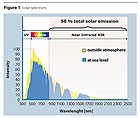
What Does Thermo Controlling Mean?
It is well known, that a white surface remains cool, while a black one heats up. The reason for this is the interaction of the coated object with the near-infrared radiation (NIR) emitted by the sun (Figure 1).The sun emits almost 50% of its energy as IR-radiation. When this NIR-radiation is absorbed, light is physically converted into heat. A surface interacts not only by absorbing radiation but also by emitting in the far-infrared region until the equilibrium at a certain temperature is reached. By using conventional pigmentation this effect could result in a severe build-up of heat.

Differently coloured pigments exhibit different, specific electromagnetic reflection profiles as shown in Figure 2.
Focusing on the IR range (780-2500 nm), a pigment like rutile yellow exhibits the highest reflection followed by titanium dioxide. On the other hand, carbon black benchmarks the lowest reflection. Compared to carbon black a considerably higher reflectance in the NIR region of the solar spectrum can be achieved by a specifically designed IR-reflecting spinel black pigment.
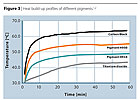
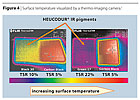
The thermo images show coated panels pigmented with different IR-reflecting pigments on the left side and with carbon black on the right side respectively. Afterwards the panels were homogeneously irradiated using an IR-lamp under defined conditions.
The advantage we can get from this approach is not only a reduction of the heat build-up that can be correlated with decreased energy consumption, but also an enhanced coating shelf life.
Due to the significant reduction in surface temperature, thermal degradation of the polymeric matrix is reduced. In addition temperature differences between day and night, direct sunlight and shadowed areas etc., will also be levelled out. As a consequence, thermal warping becomes less effective.
This aspect of the use of thermo-controlling pigments is very important, because this effect can be utilized for numerous other applications in addition to housing, roofing and facades.
This is the key reason why this approach truly deserves the label SMART. Not only because it contributes to a more environmentally aware use of resources, but also because of its exceptional ability to extend the shelf life of exterior coatings or polymers.
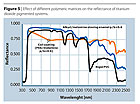
Smart Complex Inorganic Coloured Pigments
We are looking for efficient IR-reflecting pigments offered in different colour shades, exhibiting outstanding outdoor durability for their intended use in exterior coatings and available on a large scale. In order to select the right pigments we need to dig a little bit deeper into theory.
Comparing pigments with respect to their influence on the heat build-up always depends on the polymeric matrix. Figure 5 shows, as an example, the different reflectance curves of titanium dioxide in different matrices. As a consequence the characteristic absorption of solar radiation needs to be taken into consideration when designing an effective IR-reflecting coating formulation.

What is TSR?
When selecting an effective IR-reflecting pigment the most important factor is the TSR value. TSR means Total Solar Reflectance and is the integral total amount of solar energy that is immediately rejected by a surface material (e.g., coating). That means that it includes UV-, visible- as well as NIR-radiation and is thus a key figure to describe the heat build-up of surfaces.The TSR covers the entire range of radiation between UV and NIR, e.g., black pigments show systematically lower TSR values compared to white pigments for example. Therefore, only TSR values of similar pigments should be compared.
A high TSR value indicates efficient reflection – a low TSR value indicates a strong tendency to absorb NIR-light and therefore induce significant heat build-up. It is helpful to interpret the TSR value in relation to the matrix used and/or a reference pigment (e.g., titanium dioxide) (Figure 6).
Furthermore, it should be considered that even small amounts of impurities can negatively affect the TSR of the coating. Even fillers, which are usually added to the paint, can potentially reduce the resulting reflectance in the near infrared. On the other hand varying the pigment load (10% to 30%) does not generally cause notably different TSR values.
An additional influence on the scattering of electromagnetic radiation is given by the particle size distribution.


Figure 7 shows two chemically identical pigment black 30 pigments with different particle size distributions. The pigment black 30 with the particle size distribution shifted toward larger particles exhibits a significantly higher reflectance, especially in the long wavelength region, compared to the smaller particle size black 30 pigment.
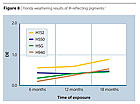
The Solution
To achieve maximum reflection of solar radiation, a NIR-reflective pigmentation of exterior coatings is required that provides a high TSR value and the highest outdoor durability. All these requirements can be fulfilled by Complex Inorganic Color Pigments (CICP), which exhibit specially designed reflectance characteristics whilst retaining their excellent weather and light fastness (Figure 8) as well as their exceptional temperature resistance.Looking at the thermo images in Figure 4 the effect of different TSR values becomes apparent. The difference in the TSR values of approximately 5% on the left panel and 17% on the right panel results in a drastically stronger heat build-up of the carbon black pigmented coil coating.
These novel, IR-reflecting complex inorganic colored pigments offer a wide range of color shades from yellow to black. They allow the formulation of not only architectural, building and construction coatings, tiles, plasters etc., but also automotive exterior and interior applications like dash-boards, fuel tanks, etc.
Because of the reduced surface temperature, the use of these pigments extends the shelf life of the polymeric matrix through a minimization of thermo-induced degradation effects and, of course, substantially reduces the heat build-up.
They therefore take care of the customer’s comfort as a result of reducing the heat build-up and thus their electric bill.
For more information see www.heubachcolor.de or Lutz.Frischmann@heubachcolor.de.

Report Abusive Comment